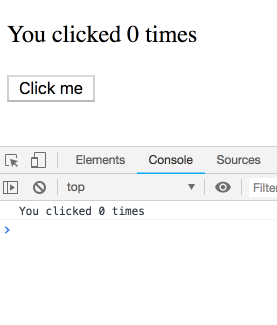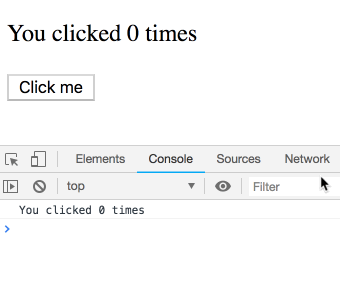React Hook和等效组件生命周期
使用像componentDidMount这样的React钩子,componentDidUpdate,componentWillUnmount和useEffect生命周期钩子的等效项是什么?
4 个答案:
答案 0 :(得分:22)
componentDidMount
将空数组作为第二个参数传递给useEffect(),以仅在安装时运行回调。
function ComponentDidMount() {
const [count, setCount] = React.useState(0);
React.useEffect(() => {
console.log('componentDidMount');
}, []);
return (
<div>
<p>componentDidMount: {count} times</p>
<button
onClick={() => {
setCount(count + 1);
}}
>
Click Me
</button>
</div>
);
}
ReactDOM.render(
<div>
<ComponentDidMount />
</div>,
document.querySelector("#app")
);<script src="https://unpkg.com/react@16.7.0-alpha.0/umd/react.development.js"></script>
<script src="https://unpkg.com/react-dom@16.7.0-alpha.0/umd/react-dom.development.js"></script>
<div id="app"></div>
componentDidUpdate
componentDidUpdate()在更新发生后立即被调用。初始渲染不调用此方法。 useEffect在每个渲染(包括第一个)上运行。因此,如果要与componentDidUpdate严格相等,则必须使用useRef来确定组件是否已安装一次。如果您想要更严格,请使用useLayoutEffect(),但它会同步触发。在大多数情况下,useEffect()就足够了。
这answer is inspired by Tholle的全部功劳归他所有。
function ComponentDidUpdate() {
const [count, setCount] = React.useState(0);
const isFirstUpdate = React.useRef(true);
React.useEffect(() => {
if (isFirstUpdate.current) {
isFirstUpdate.current = false;
return;
}
console.log('componentDidUpdate');
});
return (
<div>
<p>componentDidUpdate: {count} times</p>
<button
onClick={() => {
setCount(count + 1);
}}
>
Click Me
</button>
</div>
);
}
ReactDOM.render(
<ComponentDidUpdate />,
document.getElementById("app")
);<script src="https://unpkg.com/react@16.7.0-alpha.0/umd/react.development.js"></script>
<script src="https://unpkg.com/react-dom@16.7.0-alpha.0/umd/react-dom.development.js"></script>
<div id="app"></div>
componentWillUnmount
在useEffect的callback参数中返回一个回调,它将在卸载之前被调用。
function ComponentWillUnmount() {
function ComponentWillUnmountInner(props) {
React.useEffect(() => {
return () => {
console.log('componentWillUnmount');
};
}, []);
return (
<div>
<p>componentWillUnmount</p>
</div>
);
}
const [count, setCount] = React.useState(0);
return (
<div>
{count % 2 === 0 ? (
<ComponentWillUnmountInner count={count} />
) : (
<p>No component</p>
)}
<button
onClick={() => {
setCount(count + 1);
}}
>
Click Me
</button>
</div>
);
}
ReactDOM.render(
<div>
<ComponentWillUnmount />
</div>,
document.querySelector("#app")
);<script src="https://unpkg.com/react@16.7.0-alpha.0/umd/react.development.js"></script>
<script src="https://unpkg.com/react-dom@16.7.0-alpha.0/umd/react-dom.development.js"></script>
<div id="app"></div>
答案 1 :(得分:2)
这是React Hooks FAQ的一个很好的摘要,列出了类生命周期方法的Hooks等效项:
constructor:功能组件不需要构造函数。您可以在useState调用中初始化状态。如果计算初始状态的成本很高,则可以将函数传递给useState。
getDerivedStateFromProps:改为安排更新while rendering。
shouldComponentUpdate:请参见React.memo below。
render:这是功能组件主体本身。
componentDidMount,componentDidUpdate,componentWillUnmount:useEffect钩子可以表示所有这些组合(包括less common情况)。 / p>
componentDidCatch和getDerivedStateFromError:这些方法还没有否 Hook等效项,但很快就会添加。
componentDidMount
useEffect(() => { /*effect code*/ }, []);
[]将使效果仅在安装时运行一次。通常,您最好specify your dependencies。要使布局时序与componentDidMount相同,请查看useLayoutEffect(在大多数情况下不需要)。
componentWillUnmount
useEffect(() => { /*effect code*/ ; return ()=> { /*cleanup code*/ } }, [deps]);
componentWillUnmount对应于cleanup的效果。
componentDidUpdate
const mounted = useRef();
useEffect(() => {
if (!mounted.current) mounted.current = true;
else {
// ... on componentDidUpdate
}
});
要具有与componentDidUpdate相同的布局时序,请查看useLayoutEffect(在大多数情况下不需要)。另请参阅this post,以详细了解componentDidUpdate钩子等效项。
答案 2 :(得分:2)
为了简单说明,我想展示一个视觉参考
正如我们在上图中所看到的,对于 -
componentDidMount :
useEffect(() => {
console.log('componentWillMount');
}, []);
componentDidUpdate :
useEffect(() => {
console.log('componentWillUpdate- runs on every update');
});
useEffect(() => {
console.log('componentWillUpdate - runs if dependency value changes ');
},[Dependencies]);
componentwillUnnount :
useEffect(() => {
return () => {
console.log('componentWillUnmount');
};
}, []);
答案 3 :(得分:1)
来自React docs:
如果您熟悉React类的生命周期方法,可以考虑 useEffect Hook作为componentDidMount,componentDidUpdate和 componentWillUnmount组合。
说这些话的意思是:
componentDidMount 是useEffect(callback, [])
componentDidUpdate 是useEffect(callback, [dep1, dep2, ...])-deps数组告诉React:“如果其中一个deps被更改,则在渲染后运行回调” 。
componentDidMount + componentDidUpdate 是useEffect(callback)
componentWillUnmount 是从回调中返回的函数:
useEffect(() => {
/* some code */
return () => {
/* some code to run when rerender or unmount */
}
)
借助Dan Abramov的blog措辞,以及我自己的一些补充:
虽然您可以使用这些挂钩,但并不完全相同。与componentDidMount和componentDidUpdate不同,它将捕获道具和状态。因此,即使在回调内部,您也将看到特定渲染的属性和状态(这在componentDidMount中表示初始属性和状态)。如果您想看到“最新”的东西,可以将其写入参考。但是通常有一种更简单的方法来构造代码,以使您不必这样做。
假定可以替代componentWillUnmount的返回函数也不是完全等效的,因为该函数将在每次重新渲染组件以及卸载组件时运行。
请记住,影响的思维模型与组件生命周期不同,尝试找到其等效项可能会使您困惑甚多。为了提高工作效率,您需要“思考效果”,并且他们的思维模型更接近于实现同步,而不是响应生命周期事件。
Dan博客的示例:
function Counter() {
const [count, setCount] = useState(0);
useEffect(() => {
setTimeout(() => {
console.log(`You clicked ${count} times`);
}, 3000);
});
return (
<div>
<p>You clicked {count} times</p>
<button onClick={() => setCount(count + 1)}>
Click me
</button>
</div>
);
}
如果我们使用类实现:
componentDidUpdate() {
setTimeout(() => {
console.log(`You clicked ${this.state.count} times`);
}, 3000);
}
this.state.count始终指向最新计数,而不是属于特定渲染的计数。
- 我写了这段代码,但我无法理解我的错误
- 我无法从一个代码实例的列表中删除 None 值,但我可以在另一个实例中。为什么它适用于一个细分市场而不适用于另一个细分市场?
- 是否有可能使 loadstring 不可能等于打印?卢阿
- java中的random.expovariate()
- Appscript 通过会议在 Google 日历中发送电子邮件和创建活动
- 为什么我的 Onclick 箭头功能在 React 中不起作用?
- 在此代码中是否有使用“this”的替代方法?
- 在 SQL Server 和 PostgreSQL 上查询,我如何从第一个表获得第二个表的可视化
- 每千个数字得到
- 更新了城市边界 KML 文件的来源?


